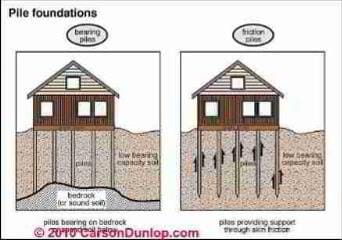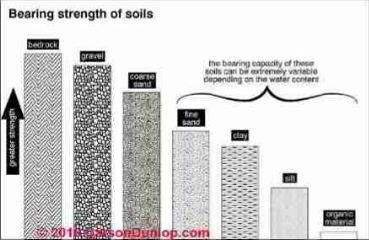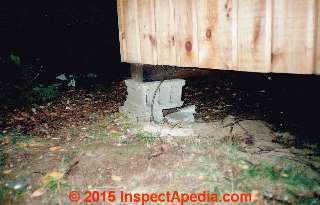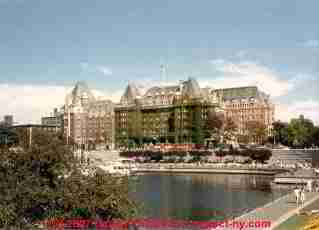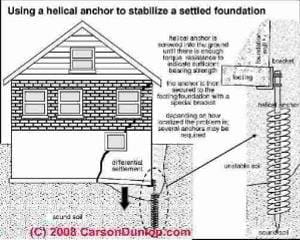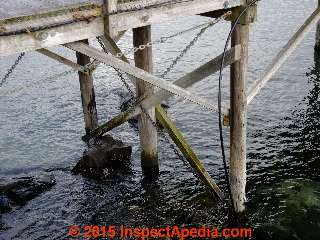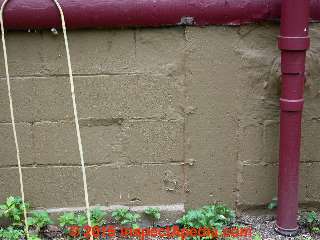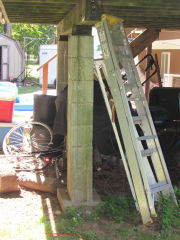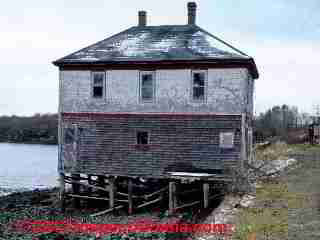 Pier or Pile Foundations
Pier or Pile Foundations
How to Detect, Diagnose, & Evaluate Settlement, Movement, Cracks, Damage
- POST a QUESTION or COMMENT about diagnosing and repairing pier or pile foundation settlement, movement, cracking in continuous wall foundations and footings or in individual posts, columns, or supporting piers.
Pier foundations:
This article discusses in detail How to Evaluate and Diagnose Movement or settlement in pier or piling foundations supporting buildings. Illustrations compare friction piers and bearing piles, types of pier/pile foundation settlement, and we discuss the role of constructing on fill or on clay soils in pier or pile performance in supporting a structure.
InspectAPedia tolerates no conflicts of interest. We have no relationship with advertisers, products, or services discussed at this website.
- Daniel Friedman, Publisher/Editor/Author - See WHO ARE WE?
Pier or Pile Foundation settlement, movement, diagnosis & repair suggestions
To be used properly, this information must be combined with specific on-site observations at the particular building in order to form a reliable opinion about the condition of that building's foundation. Anyone having concern regarding the structural stability, safety, or damage of a building, foundation or other components, should consult a qualified expert.
Our sketch at above left provided courtesy of Carson Dunlop Associates explains the difference between bearing piles (above left), and friction piles (above right). If your home is supported by either pile type and the piles were not properly installed, you can expect differential settlement, ongoing movement, and the crack pattern you describe. Below we discuss the details of inspecting structural piers on small or residential buildings.
The concrete pier shown above is cracked and damaged, perhaps from frost. If the pier was made using steel re-bar reinforcement I don't think we face an imminent collapse of the structure above but if not, that's possible. Don't confuse a cold pour joint often visible in concrete with actual cracking or frost heave damage.
See CONCRETE COLD POUR JOINTS
Reader Question about pier settlement in a New Mexico Home
I have an adobe home built in 1995. Each adobe is 10 3/4'' wide and lying on a 24'' wide X 24'' deep foundation built on soil in New Mexico with some clay.
House dirt pad was built up on original earth and 13 cement pillars were poured along the raised portion of earth. The house is 33' X 83'. Just recently the entire north portion of the house (83') has developed a crack along the tile floor and plaster wall.
The most noticeable part of this 'shift' seems to be more toward the end of the house that sits on the pillared foundation.
The bathroom wall is about half way along this wall and the sewer line sits under this portion of the house. There is a subtle but noticeable odor in this area and the tile has separated from the wall about 1''.
What is happening and how do I fix it? The doors and windows are not opening smoothly and the wall appears to be cracking at an alarming rate. I have homeowners insurance. Thanks, - L.C.
Reply: foundation diagnosis and repair suggestions for settling piers
A competent onsite inspection by an expert usually finds additional clues that help accurately diagnose a problem. For example the do-it-yourself supporting pier shown above is improper and unsafe in just about every regard.
That said, here are some things to consider:
- Your observation that a settlement crack is appearing in both the "tile floor and plaster wall" indeed suggests foundation settlement.
- Your comment about movement pointing "toward the end of the house that sits on the pillared foundation" combined with this being a modern home built in 1995 suggests that the home or part of it is supported by piers rather than a continuous footing.
- If one or more piers is settling due to inadequate or improper construction you'd have the problem you describe.
- Your observation that at least some of the supporting foundation may have been constructed on fill "House dirt pad was built up on original earth and 13 cement pillars were poured along the raised portion of earth. " is a red flag raised to question the possibility that the home was constructed on improperly or inadequately-compacted fill.
- The observation that doors and windows are sticking also suggest ongoing structural settlement. I emphasize that no one can accurately diagnose a concern like this by emailed text. You need an onsite inspection by a competent expert.
- The role of construction on fill and on clay soils will be critical in correctly diagnosing your building settlement, as Carson Dunlop Associates' sketch (above) illustrates, and as we comment further just below.
I'd be a fool to pretend to diagnose building cracks by email, not to mention sight unseen.
What to Do Next About Structural Cracking and Pier Repairs
The Victoria Hotel in on Vancouver Island (photo at left) has been settling for decades, luckily rather uniformly though a closer inspection of the hotel shows masonry cracks, especially on the rear walls.
The main entry stair of the hotel today enters on what was originally the second floor of the building. The building continues in successful and safe occupancy.
- #1 don't panic so much that an opportunist takes advantage of your worry to do something costly that may be unnecessary, inappropriate, ineffective .
The significance of a crack depends on many factors (described in our article below) such as length, width, pattern, location, building materials involved, position, etc. For example, a vertical 1 mm crack in drywall alone is unlikely to be enough movement to alone threaten an immediate catastrophe.
In general the level of risk of serious foundation or structural movement (and risk of costly damage or even collapse) depends on the total amount of movement that has occurred, where it is, over what time it occurred, what is the underlying cause, and what are the effects on the structure. Significant amounts of movement or things found way out of level and plumb are of course a bigger concern as are signs that movement is ongoing, increasing, or rapid.
- You would do well to have someone with experience with building movement, structural questions, and foundation inspection take a look. Beware: a structural engineer who is not really familiar with foundations or residential construction may have great credentials but may give crazy and expensive advice that is safe for her but expensive for you.
So before hiring anyone ask what is their experience with building cracks and movement. You could call a home inspector who has experience, a foundation repair contractor, even a general building contractor, as a starting point.
At VERTICAL MOVEMENT IN FOUNDATIONS we discuss methods for evaluating vertical foundation movement.
- You might ask your insurance company to take a look, as they may do so without charging you. Of course their "expert" may not be one, and the company will certainly exclude certain types of building problems that they assert fall outside the scope of coverage of your insurance policy.
Sketch at left provided courtesy of Carson Dunlop Associates, a Toronto home inspection, education & report writing tool company [ carsondunlop.com ]. - Inadequately-compacted fill construction? if this is the foundation problem cause diagnosis, which would not be a surprise given your description, the repair may require replacing or supplementing the existing piers with ones that are driven to adequate depth or are otherwise adequately supported.
- Expansive clay soils? include in the diagnosis of your foundation settlement the possible role played by the clay soils in your area.
Homes built on expansive clay soils may need to include special measures to avoid seasonal or even continuous foundation movement due to moisture changes in the clay soil supporting a foundation or pier.
See FROST HEAVE / EXPANSIVE SOIL CRACKS in SLABS
- Supporting structural piers in coastal areas? Piers subject to tidal waters are typically constructed using driven piles as shown in our photo below. This building is located on the Maine coast.
- Repairs? Typically, a building supported by piers that has one or more settling piers or columns is repaired by a combination of adding temporary support and then by replacing or repairing the settling piers or column footings, or by adding one or more additional piers designed for foundation repair.
A.B. Chance and others produce helical piers or driven friction piers. Helical piers are screwed into the soil and used to jack, level, and permanently support a settling structure. That may be a repair option your onsite expert may suggest. - More foundation repair suggestions for vertical movement, including a discussion of the use of helical piers, is found
at VERTICAL FOUNDATION MOVEMENT REPAIRS
The driven piles for this Maine pier are cross-braced in two directions using eyebolts and heavy chain.
Watch out: an inspector might be confused about the support beneath a home such as the one shown above.
Supported by piers a home may later have in-fill between the piers using masonry block to construct an enclosed crawl area. But these masonry blocks, if not set on suitably deep and properly-sized footing, are not supporting the structure.
Bottom line on diagnosing and repairing structural piers at a residential buildling:
If the explanation and repair advice you hear just doesn't make sense to you let me know what you were told and I can suggest some follow-up questions. And don't do anything expensive before you understand what's going on.
Keep me posted on how things progress, and send along photos if you can. Such added details can help us understand what's happening and often permit some useful further comment. What we both learn may help me help someone else.
...
Reader Comments, Questions & Answers About The Article Above
Below you will find questions and answers previously posted on this page at its page bottom reader comment box.
Reader Q&A - also see RECOMMENDED ARTICLES & FAQs
Question: comments on tall single-block stacked CMU piers under a deck
I noticed the attached CMU columns for the deck, it seemed unusual and I am thinking it's not good practice.
Appreciate your assistance in clarifying this.
Also did not like the "wood boards / shims" between the columns and girder and I did note the rot of a portions of the girder. - Dov.
Dov Ber Kahn, a home inspector in Rockland County, NY has contributed photographs of various building features to InspectApedia. Mr. Kahn is a licensed home inspector in New York and New Jersey, and can be reached at Website: Kahnbhomeinspectors, Tel: 845-445-8234, Email: kdovber@googlemail.com
Moderator reply: tall single-block masonry column, unreinforced? no connection to beam? Masonry Pier Construction Codes
Great photo and question. Do you know if there is still reinforcement and concrete fill in those columns? If not they probably exceed the allowed height for masonry peers or columns.
I count eight single concrete blocks. You don't give measurements but they look like 10" tall blocks giving an 80" tall pier + footing height + another 6" or so of blocking under that birder.
I also don't see any sign of a structural connection between the top of the masonry block column and the wood beam that it supports.
Typical codes specify
Piers between 36 and 80 inches (914 and 2032 mm) in height and all corner piers greater than 24 inches (610 mm) in height shall be at least 16 inches by 16 inches (406 mm by 406 mm) consisting of interlocking masonry units and shall be fully capped with minimum 4-inch (102 mm) solid masonry units or equivalent.
or
AE603.1 General - Piers constructed as indicated in Section AE602 may have heights as follows:
Except for corner piers, piers 36 inches (914 mm) or less in height may be constructed of masonry units, placed with cores or cells vertically. Piers shall be installed with their long dimension at right angles to the main frame member they support and shall have a minimum cross-sectional area of 128 square inches (82 560 mm2).
Piers shall be capped with minimum 4-inch (102 mm) solid masonry units or equivalent.
Piers between 36 and 80 inches (914 and 2032 mm) in height and all corner piers greater than 24 inches (610 mm) in height shall be at least 16 inches by 16 inches (406 mm by 406 mm) consisting of interlocking masonry units and shall be fully capped with minimum 4-inch (102 mm) solid masonry units or equivalent.
Piers greater than 80 inches (2032 mm) in height may be constructed in accordance with the provisions of Item 2, provided the piers shall be filled solid with grout and reinforced with four continuous No. 5 bars.
One bar shall be placed in each corner cell of hollow masonry unit piers or in each corner of the grouted space of piers constructed of solid masonry units.
Cast-in-place concrete piers meeting the same size and height limitations of Items 1, 2 and 3 may be substituted for piers constructed of masonry units.
Also of interest:
- Biggs, David T., DESIGNING TALL MASONRY WALLS [PDF] (2008) Structure Magazine, May, 2008, pp. 18-21, original source https://www.structuremag.org/wp-content/uploads/2014/08/C-Str-Design-Biggs-May08-4-10-rwf1.pdf
...
Continue reading at SINKING BUILDINGS or select a topic from the closely-related articles below, or see the complete ARTICLE INDEX.
Or see these
Recommended Articles
- COLUMNS & POSTS, DEFECTS
- DECK PIER CONSTRUCTION - how to construct a supporting reinforced-concrete pier
- SOIL PROPERTIES & BUILDING FAILURES
- VERTICAL FOUNDATION MOVEMENT REPAIRS
Suggested citation for this web page
PIER FOUNDATION PROBLEMS at InspectApedia.com - online encyclopedia of building & environmental inspection, testing, diagnosis, repair, & problem prevention advice.
Or see this
INDEX to RELATED ARTICLES: ARTICLE INDEX to BUILDING STRUCTURES
Or use the SEARCH BOX found below to Ask a Question or Search InspectApedia
Ask a Question or Search InspectApedia
Try the search box just below, or if you prefer, post a question or comment in the Comments box below and we will respond promptly.
Search the InspectApedia website
Note: appearance of your Comment below may be delayed: if your comment contains an image, photograph, web link, or text that looks to the software as if it might be a web link, your posting will appear after it has been approved by a moderator. Apologies for the delay.
Only one image can be added per comment but you can post as many comments, and therefore images, as you like.
You will not receive a notification when a response to your question has been posted.
Please bookmark this page to make it easy for you to check back for our response.
IF above you see "Comment Form is loading comments..." then COMMENT BOX - countable.ca / bawkbox.com IS NOT WORKING.
In any case you are welcome to send an email directly to us at InspectApedia.com at editor@inspectApedia.com
We'll reply to you directly. Please help us help you by noting, in your email, the URL of the InspectApedia page where you wanted to comment.
Citations & References
In addition to any citations in the article above, a full list is available on request.
- Mark Cramer Inspection Services Mark Cramer, Tampa Florida, Mr. Cramer is a past president of ASHI, the American Society of Home Inspectors and is a Florida home inspector and home inspection educator. Mr. Cramer serves on the ASHI Home Inspection Standards. Contact Mark Cramer at: 727-595-4211 mark@BestTampaInspector.com
- John Cranor [Website: /www.house-whisperer.com ] is an ASHI member and a home inspector (The House Whisperer) is located in Glen Allen, VA 23060. He is also a contributor to InspectApedia.com in several technical areas such as plumbing and appliances (dryer vents). Contact Mr. Cranor at 804-873-8534 or by Email: johncranor@verizon.net
- A.B. ChanceFoundation repair systems, helical piers, foundation repairs www.abchance.com
- "Backfilling Basics," Buck Bartley, Journal of Light Construction, October 1994
- Dwyer of Florida, supplier of Helical Piles, foundation repair, and concrete restoration in Florida, exclusive dealer for Magnum piering. This company provides helical piles, foundation settlement repair, concrete restoration, shotcrete, pressure grouting, and slabjacking for residential and commercial buildings. 1-866-900-PIER www.dwyerflorida.com
- The Circular Staircase, Mary Roberts Rinehart
- Construction Drawings and Details, Rosemary Kilmer
- CRAWL SPACE MOISTURE CONTROL [PDF] U.S. Department of Energy
- Diagnosing & Repairing House Structure Problems, Edgar O. Seaquist, McGraw Hill, 1980 ISBN 0-07-056013-7 (obsolete, incomplete, missing most diagnosis steps, but very good reading; out of print but used copies are available at Amazon.com, and reprints are available from some inspection tool suppliers). Ed Seaquist was among the first speakers invited to a series of educational conferences organized by D Friedman for ASHI, the American Society of Home Inspectors, where the topic of inspecting the in-service condition of building structures was first addressed.
- Design of Wood Structures - ASD, Donald E. Breyer, Kenneth Fridley, Kelly Cobeen, David Pollock, McGraw Hill, 2003, ISBN-10: 0071379320, ISBN-13: 978-0071379328
This book is an update of a long-established text dating from at least 1988 (DJF); Quoting:
This book is gives a good grasp of seismic design for wood structures. Many of the examples especially near the end are good practice for the California PE Special Seismic Exam design questions. It gives a good grasp of how seismic forces move through a building and how to calculate those forces at various locations. THE CLASSIC TEXT ON WOOD DESIGN UPDATED TO INCLUDE THE LATEST CODES AND DATA. Reflects the most recent provisions of the 2003 International Building Code and 2001 National Design Specification for Wood Construction. Continuing the sterling standard set by earlier editions, this indispensable reference clearly explains the best wood design techniques for the safe handling of gravity and lateral loads. Carefully revised and updated to include the new 2003 International Building Code, ASCE 7-02 Minimum Design Loads for Buildings and Other Structures, the 2001 National Design Specification for Wood Construction, and the most recent Allowable Stress Design. - Building Failures, Diagnosis & Avoidance, 2d Ed., W.H. Ransom, E.& F. Spon, New York, 1987 ISBN 0-419-14270-3
- Domestic Building Surveys, Andrew R. Williams, Kindle book, Amazon.com
- Defects and Deterioration in Buildings: A Practical Guide to the Science and Technology of Material Failure, Barry Richardson, Spon Press; 2d Ed (2001), ISBN-10: 041925210X, ISBN-13: 978-0419252108. Quoting:
A professional reference designed to assist surveyors, engineers, architects and contractors in diagnosing existing problems and avoiding them in new buildings. Fully revised and updated, this edition, in new clearer format, covers developments in building defects, and problems such as sick building syndrome. Well liked for its mixture of theory and practice the new edition will complement Hinks and Cook's student textbook on defects at the practitioner level. - Guide to Domestic Building Surveys, Jack Bower, Butterworth Architecture, London, 1988, ISBN 0-408-50000 X
- "Avoiding Foundation Failures," Robert Marshall, Journal of Light Construction, July, 1996 (Highly recommend this article-DF)
- "A Foundation for Unstable Soils," Harris Hyman, P.E., Journal of Light Construction, May 1995
- "Backfilling Basics," Buck Bartley, Journal of Light Construction, October 1994
- "Inspecting Block Foundations," Donald V. Cohen, P.E., ASHI Reporter, December 1998. This article in turn cites the Fine Homebuilding article noted below.
- In addition to citations & references found in this article, see the research citations given at the end of the related articles found at our suggested
CONTINUE READING or RECOMMENDED ARTICLES.
- Carson, Dunlop & Associates Ltd., 120 Carlton Street Suite 407, Toronto ON M5A 4K2. Tel: (416) 964-9415 1-800-268-7070 Email: info@carsondunlop.com. Alan Carson is a past president of ASHI, the American Society of Home Inspectors.
Thanks to Alan Carson and Bob Dunlop, for permission for InspectAPedia to use text excerpts from The HOME REFERENCE BOOK - the Encyclopedia of Homes and to use illustrations from The ILLUSTRATED HOME .
Carson Dunlop Associates provides extensive home inspection education and report writing material. In gratitude we provide links to tsome Carson Dunlop Associates products and services.


